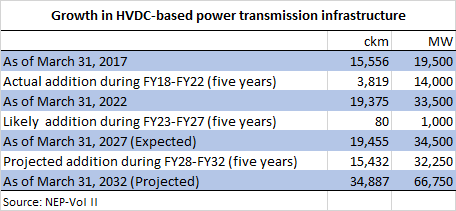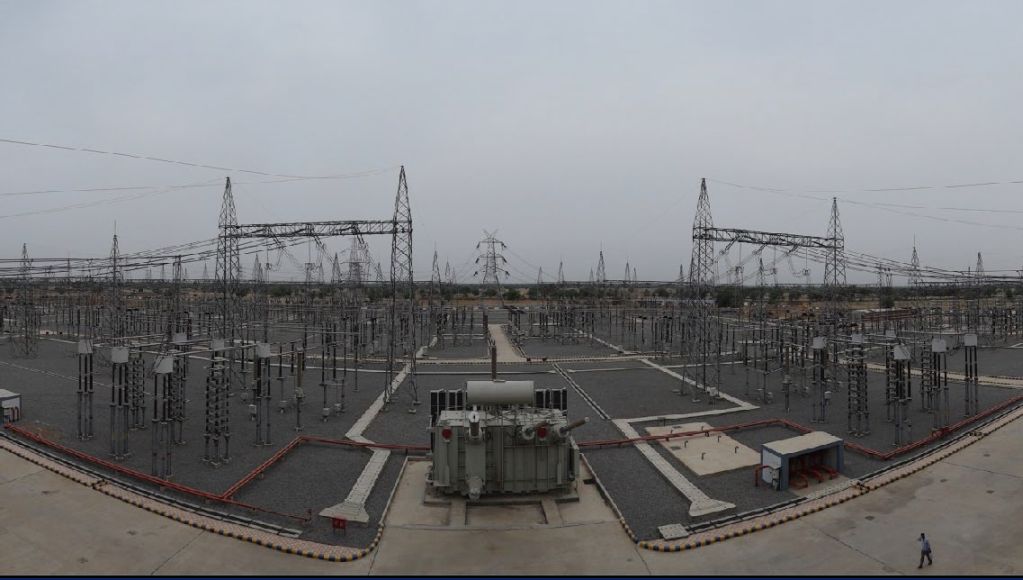The five-year period from FY28 to FY32 (April 1, 2027 to March 31, 2032) is likely to see a major build-up of HVDC-based power transmission infrastructure.
According to the newly-released National Electricity Plan (Vol 2 – Transmission), during the FY28-FY32 period, a total of 15,432 ckm of HVDC-based transmission lines and 32,250 MW of HVDC-based transfer capacity is likely to be added.
This implies an 80 per cent growth in HVDC lines and a near-doubling of HVDC transfer capacity, compared to current levels.
After the full commissioning of the ±800kV Raigarh-Pugular HVDC link in FY22, India has seen no new addition of HVDC-based power transmission infrastructure. However, serious planning and deliberations on new HVDC links have taken place in recent years, and this is expected to result in significant addition of HVDC-based infrastructure during the FY28-FY32 period.
 As can be seen from the table alongside, a total of 3,819 ckm and 14,000 MW of HVDC infrastructure was added in the five-year period from FY18 to FY22 (April 1, 2017 to March 31, 2022). This was also the period when the Raigarh-Pugalur HVDC link was commissioned.
As can be seen from the table alongside, a total of 3,819 ckm and 14,000 MW of HVDC infrastructure was added in the five-year period from FY18 to FY22 (April 1, 2017 to March 31, 2022). This was also the period when the Raigarh-Pugalur HVDC link was commissioned.
In the subsequent years – FY23, FY24 and ongoing FY25 – no HVDC infrastructure is expected. However, during FY26, it is expected that 80 ckm of lines and 1,000 MW of HVDC transfer capacity will be commissioned. This would be part of the intrastate transmission system (InSTS) scheme that Adani Energy Mumbai Infrastructure Ltd is developing under the regulated tariff mechanism (RTM) in Maharashtra. As part of the project, VSC-based converter stations (1,000 MW, HVDC) will be set up at Aarey and Kudus. There will be an 80-ckm double-circuit line, of ±320kV, connecting the two terminal stations.
With this scheme, the total addition in the FY23-FY27 period will stand at 80 ckm and 1,000 MW, taking the cumulative HVDC-based infrastructure to 19,455 ckm and 34,500 MW, by March 31, 2027.
Additions in FY28-FY32
As mentioned earlier, during the FY28-FY32 period, a total of 15,432 ckm of HVDC-based transmission lines and 32,250 MW of HVDC-based transfer capacity is likely to be added. Some of the schemes by which this capacity build-up is expected are:
- Bhadla (Rajasthan) to Fatehgarh (Uttar Pradesh) [±800kV, 6000 MW]
- Bikaner-V (Rajasthan) to Begunia (Odisha) [±800kV, 6000 MW]
- Barmer-II (Rajasthan) to South Kalamb (Maharashtra) [±800kV, 6000 MW]
- Leh (UT of Ladakh) to Kaithal (Haryana) [±350kV, 5000 MW]
- KPS2 (Gujarat) to Nagpur (Maharashtra) [±800kV, 6000 MW]
- Paradeep (Odisha) to Port Blair (A&N Islands) [±320kV, 250 MW]
The extremities will be HVDC terminals and these will be interconnected by HVDC lines. These projects will use a mix of TBCB and RTM modalities. From a technical perspective, two technologies – VSC and LCC – are available. The Plan document states that for upcoming schemes (other than those under bidding or under construction), the choice of technology will be decided when the technical parameters of the project are finalized.
New paradigms
Much of India’s current HVDC-based power transmission infrastructure has been set up by Power Grid Corporation of India Ltd (PGCIL).
For the record, there is one privately-owned HVDC line running 986 km from Mundra (Gujarat) to Mohindergarh (Haryana). This ±500kV line with a maximum transfer capacity of 2,500 MW was set up in 2011 by Adani Group – at a time when India, as a nation, had limited experience with HVDC technology. This was India’s first private sector HVDC line and continues to hold the distinction till date. The link is used to transmit electricity from Adani Power’s Mundra thermal plant in Gujarat to north India.
Being lines of national importance, PGCIL was nominated as the implementing agency of all HVDC lines. Even after the tariff-based competitive bidding (TBCB) mechanism was introduced in early 2011, PGCIL continued to nominated as the developing agency for HVDC projects, under the regulated tariff mechanism (RTM).
Speaking of recent RTM mandates, PGCIL will be developing the Leh-Kaithal HVDC scheme as well as those associated with evacuation of wind energy offshore Tamil Nadu and Gujarat.
TBCB steps in
However, what is inspiring to observe is that several HVDC schemes have been proposed for development under the TBCB mode. This is an important shift in paradigm as it provides unprecedented opportunity to private sector players to shape India’s HVDC-based power transmission infrastructure.
Very recently, the results of India’s very first ISTS-TBCB project involving HVDC technology were announced and the project housed under “Khavda V-A Power Transmission Ltd” was formally awarded to PGCIL. The Central PSU had also emerged L1 for another HVDC-centric ISTS-TBCB project incorporated under “Rajasthan Part I Power Transmission Ltd”. However, the bidding process was annulled and the project is being re-tendered.
It is estimated that through ISTS-TBCB projects currently under bidding, a total of 14,500 MW of transfer capacity and 5,500 ckm of transmission lines will be based on HVDC technology. These projects include “Khavda V-A” and “Rajasthan Part I” discussed above.
Featured photograph (source: AESL) shows the HVDC switchyard at Mundra, Gujarat, associated with the company’s Mundra-Mohindergarh HVDC link.



